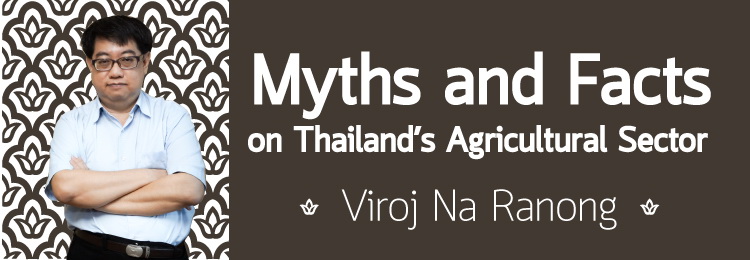Viroj Na Ranong, PhD
TDRI’s Research Director
Over the past few decades, Thailand as a major exporter of a range of agricultural produce has sought to pressure other countries to stop their agri-cultural subsidies and open their markets to free trade.
Even when faced with resistance from the more developed countries,many of which cited non-economic reasons such as cultural concerns and the multi-functionality of agriculture to justify continuing to support their economically inefficient farmers, Thailand and its allies notably the Cairns Group has won some disputes and reached settlements.
Some have resulted in Thailand receiving compensation from the European Union (EU), forcing it to reduce its support/protection schemes.
However, anyone who has followed agricultural news in Thailand recently might have been under the impression that our agricultural sector has lost its competitiveness to the extent that our farmers can now only rely on government support for the sector to survive.
Low yields, high costs and heavy reliance on exports have always been cited as the major plagues limiting the competitiveness of Thai agriculture.
The fact of the matter is that these shortcomings are nothing new, and despite some of these shortcomings, our agricultural sector has always been able to strive rather successfully in the world market, and continue to expand and improve, even with meagre support from the government in the past.
Thailand’s rice exports have increased from about 2 million tonnes annually in 1978-80 to 9-11 million tonnes per year during 2008-2011.
The figures rose until last year, when the government decided to intervene in the rice market.
The same applied to cassava, of which Thailand has been the world’s leading exporter over the past three decades.Sugar production has also increased from 2 million tonnes per year in 1982 to 10 million tonnes annually in the past two years, making Thailand the world’s second largest exporter (after Brazil) over the past 15 years.
Most notably, natural rubber production has increased by almost 50%from 2 million tonnes annually to 3 million tonnes in only a decade.
Although these increases have been influenced in part by some of the government’s support programmes, no one can deny the resilience of the sector that has been able to adjust itself and, in terms of its performance, has been able to overcome shortcomings cited by the critics, even with rather limited support from the government.
Along the way, we have witnessed several changes in the agricultural sector that have helped farmers cope with the problems they face. As farmers grow older and many families choose to send their children away from agriculture, mechanisation can be employed now at a lower cost and with higher efficiency in almost every major step of rice and sugarcane production.
This has made it possible for ageing farmers to increase their production by expanding the size of their farm as well as speeding up their crop cycle through multiple crops.
For workers who decide to remain in the agricultural sector, many work in specialised units for hire that move from one farm to another. They may, for example, work in rice broadcasting, pesticide and herbicide operations, or as tractor or combine harvester drivers.
This kind of division of labour has enabled them to be almost fully employed in agriculture, an industry that was notorious for unemployment during the non-peak times in the past.
This arrangement has been seen to work especially well in irrigated areas where production, and thus employment,are now year-round.
In terms of productivity, the mythical low yield rate of Thai rice has been a combined result of our lack of irrigated areas (less than 20% in the rainy season and less than 10% in the dry season)and our choice to go with high-value but low-yield rice varieties such as Jasmine in non-irrigated areas.
In areas where water can be controlled and high-yield varieties are planted,paddy yield is about 800-1,000kg per rai, which is comparable with or at least only slightly lower than that of Vietnam, which tends to employ a more delicate farming approach due to its labour abundance.
As for the primary processing units,medium- and large-sized rice and sugar mills are now equipped with state-ofthe-art technologies, enabling them to process high quality produce.
This has helped Thai rice command a premium price above most of the country’s competitors. Good logistics and historic competency of our exporters has also added a competitive edge to the sector.
In recent years, one major myth about Thai agriculture has been that farmers cannot sustain their livelihoods without price intervention by the government.Believing in this myth has led every government and major political party to focus on pricing policies, and raced to promise the farmers that they can deliver a price above the world rate to them.
For an importing country, it is not very difficult to deliver such a promise.The government can make the domestic price higher than the world price by simply raising import taxes or setting an import quota. It can use the tax or quota revenue to provide extra support to the farmers.
But as an exporting country, Thailand needs to sell all of its surplus to the world market, and usually it cannot sell at a higher price than the market price.
To make the domestic price higher than the world price means we are using our taxpayers’ money to support consumers in all the importing countries.
The more we export, the greater the burden to our taxpayers. Worse, higher prices paid to farmers will translate to more production and exports. Therefore,it is not sustainable for the government of an exporting country to keep the price above the world price indefinitely.
_________________________________________________________
Viroj Na Ranong, PhD, is Research Director at Thailand Development Research Institute (TDRI). Policy analyses from the TDRI appear in the Bangkok Post on alternate Wednesdays.
Source: Bangkok Post, 11 September 2013

